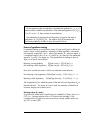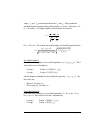
Page 18-37
The value of β, i.e., the probability of making an error of Type II, depends on α,
the sample size n, and on the true value of the parameter tested. Thus, the
value of β is determined after the hypothesis testing is performed. It is
customary to draw graphs showing β, or the power of the test (1- β), as a
function of the true value of the parameter tested. These graphs are called
operating characteristic curves or power function curves, respectively.
Inferences concerning one mean
Two-sided hypothesis
The problem consists in testing the null hypothesis H
o
: μ = μ
o
, against the
alternative hypothesis, H
1
: μ≠ μ
ο
at a level of confidence (1-α)100%, or
significance level α, using a sample of size n with a mean ⎯x and a standard
deviation s. This test is referred to as a two-sided or two-tailed test. The
procedure for the test is as follows:
First, we calculate the appropriate statistic for the test (t
o
or z
o
) as follows:
Θ If n < 30 and the standard deviation of the population, σ, is known, use the
z-statistic:
Θ If n > 30, and σ is known, use z
o
as above. If σ is not known, replace s for
σ in z
o
, i.e., use
Θ If n < 30, and σ is unknown, use the t-statistic , with ν = n - 1
degrees of freedom.
Then, calculate the P-value (a probability) associated with either z
ο
or t
ο
, and
compare it to α to decide whether or not to reject the null hypothesis. The P-
value for a two-sided test is defined as either
P-value = P(|z|>|z
o
|), or, P-value = P(|t|>|t
o
|).
n
x
z
o
o
/
σ
μ
−
=
ns
x
z
o
o
/
μ
−
=
ns
x
t
o
o
/
μ
−
=


















